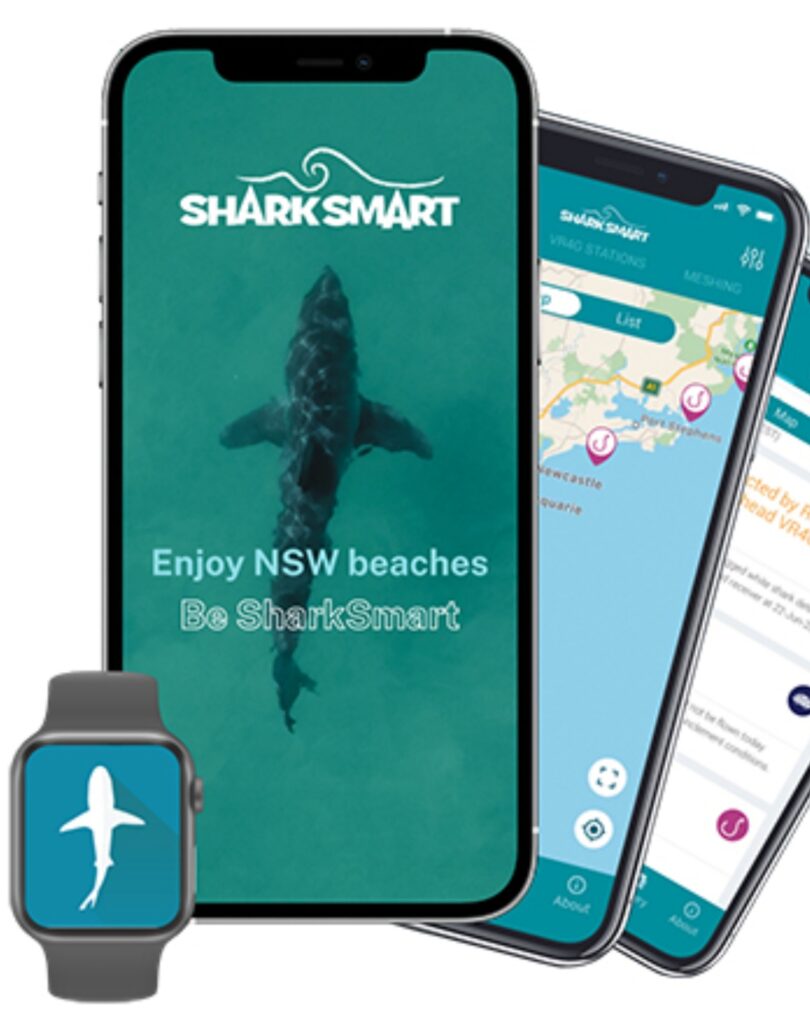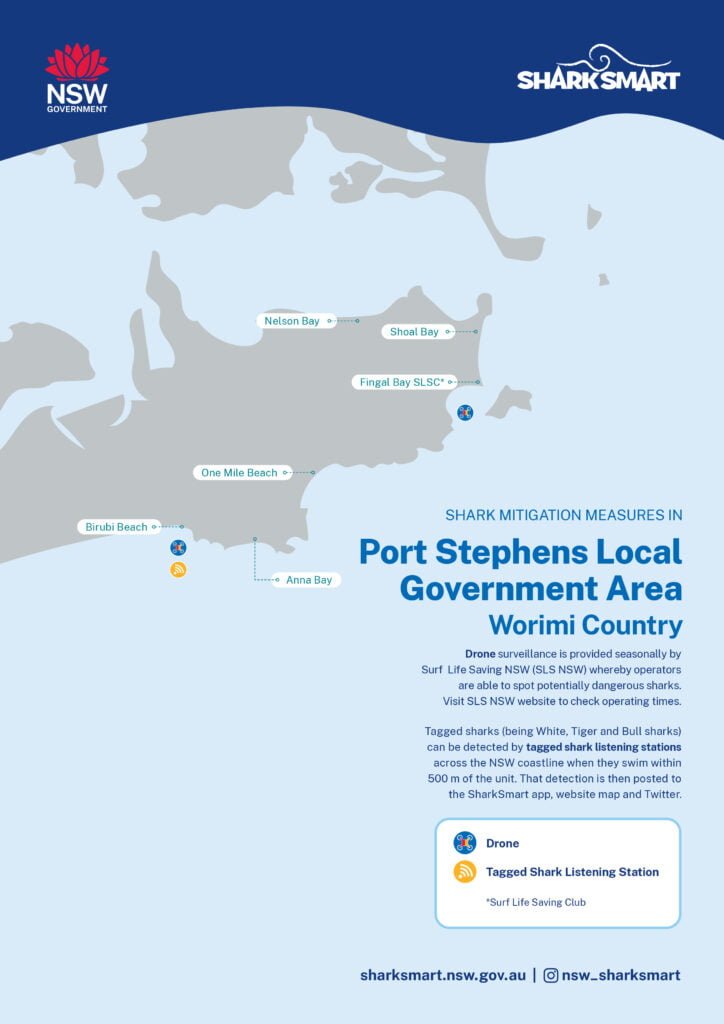NSW Shark Management Program in Port Stephens
The Port Stephens–Great Lakes Marine Park protects some of the state’s most spectacular and rich marine biodiversity, including many dolphin, turtle, fish, seabird and seaweed species – and shark species. Sharks are a natural part of healthy oceanic and estuarine environments.
The word ‘shark’ is used to describe a broad range of aquatic creatures, but not all sharks are dangerous to humans. Nearly all serious shark bites have been attributed to just three species: white sharks, bull sharks and tiger sharks. These sharks are referred to as ‘target sharks’ and are the focus of the NSW Government’s Shark Management Program.
What is the Shark Management Program?
The NSW Shark Management Program aims to increase protection for beachgoers while minimising harm to sharks and other marine life. It stretches from Tweed Heads on the far north coast to Pambula Beach on the far south coast. The Program includes:-
- 305 SMART drumlines in 19 coastal local government areas (LGA) from Tweed to Bega
- Nets at 51 beaches across 8 LGAs between Newcastle and Wollongong from 1 September to 30 April each year
- Surf Life Saving NSW drone patrols at up to 50 beaches during school holidays with at least one drone in every LGA
- 37 tagged shark listening stations, with at least one in every LGA
- Surfing NSW partnership to provide shark mitigation support and services such as trauma kits and drones; and
- The state-wide SharkSmart community education and awareness campaign, the SharkSmart app, and shark and social research
In the Port Stephens region, there is a tagged shark listening station at Birubi Beach, and drone patrols at Fingal Bay and Birubi Point during the spring, summer and autumn school holidays. Shark nets and SMART drumlines are not used in the Port Stephens region.
Shark Management in Port Stephens
You may be familiar with the large yellow buoy that is located approximately 500m offshore at Birubi Point. That buoy is a “tagged shark listening station”.
Tagged shark listening stations record the presence of tagged animals swimming within 500m. When a tagged target shark (white, tiger or bull shark) swims within 500m of a tagged shark listening station, an alert is sent to the public via the SharkSmart App.
Shark tagging has also enabled scientists to track the natural movements of the sharks to determine the environmental and biological factors affecting their distribution in coastal waters.
In 2022/23, the Birubi Point and Fingal Bay drone patrols delivered over 400 hours of shark surveillance in the Port Stephens region. Twenty-one counter measures were used (e.g. beach closures) following the sightings of one white shark, 12 bull sharks and 13 unknown sharks.
The Shark Education team has also visited three local events in the last 14 months, providing the community with an opportunity to learn about shark movements, research and mitigation technologies.
SharkSmart in Port Stephens
Data from the Shark Management Program suggests that a ‘white shark nursery’ is thought to extend from South West Rocks on the mid north coast and south to about Terrigal in the south
From analysing tagged shark detection data, we have found that:
- White sharks typically move north into NSW waters for autumn and winter and move south for spring and summer
- Bull and tiger sharks typically travel north into Queensland and northern NSW waters for winter and south into NSW waters for summer
- All target species travel great distances and are not permanent residents of any one location
- All target sharks exhibit ‘philopatric behaviour’ which means they return to particular reefs and habitats repeatedly during their life due to environmental conditions, prey availability and mating.
Looking at Birubi listening station data, there appear to be obvious seasonal trends. From June to November there is a significant increase in the number of white shark detections. From December to May, white shark detections decline markedly as they migrate further south and there is a slight increase in the number of bull and tiger shark detections. Although there are seasonal trends in the abundance of target sharks, there are always sharks along the NSW coast.
When comparing the listening station data collected from all 25 coastal local government areas, Port Stephens ranks 5th in total number of individual target sharks detected, and 8th in total number of detections. However, abundance of sharks does not necessarily correlate to a higher number of human/shark incidents.
The last serious incident in Port Stephens involving a white shark occurred over 10 years ago and was within the estuary, despite the relatively high abundance of sharks in the Port Stephens area.
How to be SharkSmart
One of the simplest safety routines to follow is to only swim at patrolled beaches and to stay between the flags. This is the safest place to swim because lifesavers and lifeguards are there to monitor beach and water conditions. Patrolled beaches may also sound shark alarms.
SharkSmart swimmers and surfers:
- Tell an on-duty lifesaver or lifeguard if you see a shark
- Stay close to shore when swimming
- Swim, dive or surf with other people
- Avoid swimming and surfing at dawn, dusk and night
- Keep away from murky, dirty water
- Avoid areas used by recreational or commercial fishers
- Avoid areas with signs of diving seabirds, bait fish or fish feeding activity
- Dolphins do not indicate the absence of sharks; both often feed together on the same food
- Be aware that sharks may be present between sandbars or near steep drop offs
- Avoid swimming in canals and swimming or surfing in river/harbour mouths
- Consider using a personal deterrent that has been independently tested and verified.
SharkSmart divers, snorkellers and spearfishers:
- Be aware that using bait to lure fish may attract sharks.
- Don’t chase, grab, corner, spear or touch a shark.
- Don’t use bait or otherwise attempt to feed a shark while underwater. Feeding may radically change the shark’s behaviour and may lure other sharks.
- If a shark appears excited or agitated, exhibiting quick, jerky movements or other erratic behaviour, leave the water as quickly and calmly as possible.
- If fish suddenly dive for cover or appear agitated, leave the water quickly and calmly as a shark may be nearby.
- Do not attach speared fish to your body or keep them near you; use a float and line to keep your catch well away.

Download the SharkSmark app for useful tips on reducing the risk of a shark encounter and for the latest advice, alerts and information this summer.
Threatened species
The Port Stephens-Great Lakes Marine Park is zoned to protect the park’s biodiversity while providing for a range of uses. The Park is home to a variety of sharks, including the vulnerable White Shark and Great Hammerhead Shark, the endangered Scalloped Hammerhead Shark, and the critically endangered Grey Nurse Shark. It is illegal to target, take, possess, harm or attempt to harm and sell any threatened species in NSW without a specific permit, licence or other appropriate authority. Failure to comply could result in significant penalties.
There can also be significant penalties for causing damage to the habitat of a threatened species without approval. The following areas within the Marine Park are declared critical habitats for the Grey Nurse Shark (as at January 2007):
- The Pinnacle
- Big Seal and Little Seal at Seal Rocks
- Little Broughton Island.
These locations all have specific rules and regulations in force that focus on the protection of this integral species. Please familiarise yourself with these rules and regulations prior to fishing in permissible areas of the Port Stephens-Great Lakes Marine Park.
In addition, these locations have permissible scuba diving rules and regulations that must be adhered to. Permitted activities do not include any of the following: night diving; blocking an entrance to a cave or gutter containing a shark; feeding or touching a shark; chasing or harassing a shark; wearing or using an electronic shark repelling device; or using a powered scooter.
For more information in relation to zoning and permitted uses of the Port Stephens-Great Lakes Marine Park, please download the NSW FishSmart app or follow this link and read more about the Marine Park and its zones here.
Note from EcoUpdate Editor: Many thanks to the team from the NSW Shark Management Program for contributing such an informative article and including valuable Port Stephens site-specific data.





